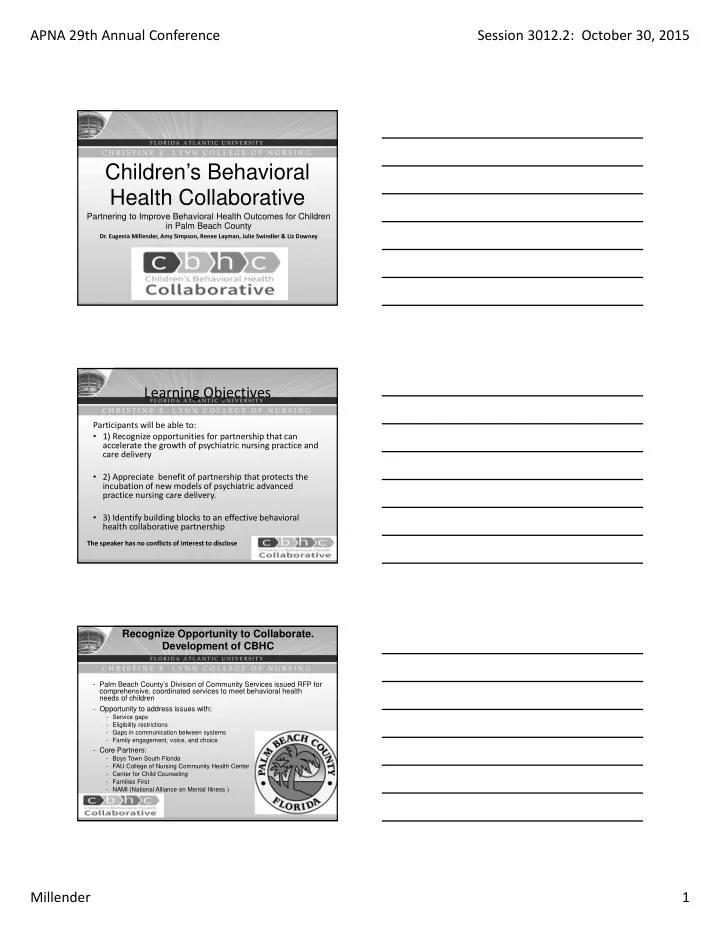

APNA 29th Annual Conference Session 3012.2: October 30, 2015 Children’s Behavioral Health Collaborative Partnering to Improve Behavioral Health Outcomes for Children in Palm Beach County Dr. Eugenia Millender, Amy Simpson, Renee Layman, Julie Swindler & Liz Downey Learning Objectives Participants will be able to: • 1) Recognize opportunities for partnership that can accelerate the growth of psychiatric nursing practice and care delivery • 2) Appreciate benefit of partnership that protects the incubation of new models of psychiatric advanced practice nursing care delivery. • 3) Identify building blocks to an effective behavioral health collaborative partnership The speaker has no conflicts of interest to disclose Recognize Opportunity to Collaborate. Development of CBHC - Palm Beach County’s Division of Community Services issued RFP for comprehensive, coordinated services to meet behavioral health needs of children - Opportunity to address issues with: - Service gaps - Eligibility restrictions - Gaps in communication between systems - Family engagement, voice, and choice - Core Partners: - Boys Town South Florida - FAU College of Nursing Community Health Center - Center for Child Counseling - Families First - NAMI (National Alliance on Mental Illness ) Millender 1
APNA 29th Annual Conference Session 3012.2: October 30, 2015 CBHC Objectives • Work toward a comprehensive system of care to assists children in achieving success in school and in the community, and stabilizes their social and emotional functioning; • Assist children and their families in their efforts to access an array of services from preventative services to intensive interventions and both formal and informal supports; and, • Encourage effective utilization of resources by reducing duplication, maximizing resources, and collaboration across agencies and systems. Eligibility Criteria • Currently, within our system of care, and following the guidelines established by AHCA/Medicaid, a child must have a documented mental health diagnosis and the need for coordinated services in order to be eligible for Targeted Case Management (TCM). • Through the CBHC, children/adolescents who are not otherwise eligible (no MH diagnosis, or the primary diagnosis is substance abuse or a developmental disorder) can be served, as well as those who do have a documented mental health diagnosis. Overview of Core Partners • Florida Atlantic University Christine E. Lynn College of Nursing Community Health Center – Psychiatric Assessment, Medication Management, and Health Services • Boys Town – Care Coordination Services • Center For Child Counseling – Individual, Family, and Group Therapy • Families First – Individual, Family, and Group Therapy • National Alliance on Mental Illness- PBC – Peer Support, Family Education and Support, Functional Skills training, Advocacy and Outreach Millender 2
APNA 29th Annual Conference Session 3012.2: October 30, 2015 Benefits of Partnership • Community Collaboration • Community Partners market your skills/programs • Co ‐ locating • Sharing resources • Seeking grants together Building blocks to an effective collaboration • Excellent communication at all levels – Frequent meetings to start then monthly • Transparency – Budgets, staffing, resources, needs • Respect • Diverse set of skills • Agree on level of responsibilities and distribution • Frequent review of outcome and timeline Broader System ‐ Established MOUs with several agencies in order to (64): ‐ Ensure family voice and choice ‐ Provide comprehensive resources to meet the behavioral health needs of children, from prevention and outreach to intensive residential treatment ‐ Educate and inform system of range of resources and services available to children and families ‐ MOU process ‐ Request through any CBHC partner ‐ Add services available to children and families in section 2 ‐ Signed by all parties ‐ Arrange for presentation to CBHC ‐ Agency Staff Meetings ‐ CBHC Operations Meeting ‐ CBHC Steering Committee Millender 3
APNA 29th Annual Conference Session 3012.2: October 30, 2015 Initial Outcomes - Referrals • 453 children assessed and triaged • Referred from 64 unique sources Initial Outcomes – Case Process Average days between: Referral to Initial Visit 30 Initial Visit to Service Referral 7 Service Referral to Open 9 Admissions up 64% net increase of 98 youth compared to same time period last year Average Length of Stay: January – June 2014 discharges 1 year, 6 days January – June 2015 discharges 9 months, 7 days Initial Outcomes – CFARS data % of youth showing improvement/stability – Q3 2014/15 100% 90% 80% 70% 60% All Youth 50% SEFBHN 40% Medicaid 30% FAA 20% 10% 0% Behavior At Social Behavior at Home Emotional School/Work Functioning Millender 4
APNA 29th Annual Conference Session 3012.2: October 30, 2015 Essential tool in collaboration • Communication – Communication • Communication – Communication » Communication • Communication • Communication • Communication • Communication Thank You! References • National Institute of Mental Health Release of landmark and collaborative study conducted by Harvard University, the University of Michigan and the NIMH Intramural Research Program (release dated June 6, 2005 and accessed at www.nimh.nih.gov). • U.S. Public Health Service, Report of the Surgeon General’s Conference on Children’s Mental Health: A National Action Agenda. Washington, DC: Department of Health and Human Services, 2000. Millender 5
Recommend
More recommend